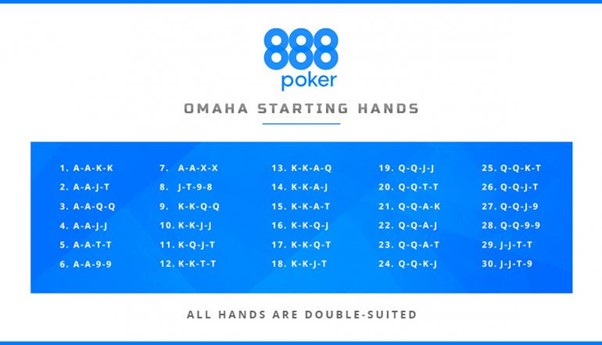Whether to take advantage of softer games or challenge mastering a new poker variant, there are many good reasons to try Pot Limit Omaha for the first time.
A common saying among players is that if No Limit Hold’em is the Cadillac of poker, then Pot Limit Omaha must be the Ferrari.
Undoubtedly, PLO is fast, exciting and offers lots of action.
Making the transition to PLO is not straightforward, though.
In this 888poker guide, we’ll give you some tips for approaching PLO for the first time whilst avoiding common beginner mistakes.
Starting Hands in PLO
We get dealt four starting cards in PLO, which makes it much easier to make big poker hand rankings postflop.
Players from a Hold’em background might mistakenly assume their hand is strong because two of their four cards work together well.
For example, they might hold an AKxx or JJxx.
Unfortunately, these hands are prevalent in PLO and not always that strong.
Ideally, we are looking for starting hands that coordinate well across all FOUR cards. Examples include holdings like AAJT, QQJJ or QJT9. We also prefer holdings that have exactly two cards of each suit.

With 270,725 possible starting hand poker combos in Omaha, starting hand selection can initially seem overwhelming. A great starting point is to focus purely on how many high cards we are dealt – the more, the better.
For example, holding four cards of rank nine or higher is playable from almost any position, especially if some of the cards are suited.
Postflop Hand Strength in PLO
Since big postflop hands are much more common in PLO, we can’t think of hands in the same way as we might in Hold’em. Hands that are strong in Hold’em, such as overpairs and two pairs, are relatively weak in PLO.
As a rough guide, our objective should be to make postflop holdings that are either the nuts or quite close to it.
Dominated flushes, straights and full houses can be a big problem hands for inexperienced PLO players. These hands are very strong in Hold’em but are nearly always dominated in PLO when facing a large amount of action.
By far, the most significant mistake new PLO players make is over-valuing the AAxx overpair postflop since this hand is naturally very strong in Hold’em.
The Two Card Rule
In Pot Limit Omaha, players must always use exactly two of their hole cards when making a hand.
It's easy to forget this since we can use either two, one or none of our whole cards when making a hand in Hold'em.
In PLO, it’s almost a rite of passage for a new player to lose their shirt – not playing strip poker - thinking they have a flush when they don’t.
Here are two examples of common hand misreads in PLO -
Hole Cards – AT52
Board – QQQA2

Ah yes…..queens full of aces. Wait a minute…. We can’t just use our ace in the hole along with four cards from the board.
We must always use exactly two of our hole cards.
We just have three-of-a-kind queens with ace-ten kickers. Oops….
A standard pattern to remember is that if three cards of the same rank are on the board, only a pocket pair in the hole allows us to make a full house.
Hole Cards – Ace of hearts in the hole.
Board – Four hearts on the board.

Great, the nut flush with my lone ace in the hole! Wait, why did I just lose the entire pot?!
In Omaha, we need two flush cards in the hole and exactly three on the board to make a flush.
Having more than two suited flush cards in the hole is less optimal. It decreases the chance of us being able to make a flush.
PLO players describe this as “blocking their own outs”.
Wraps in PLO
In Hold’em, our straight draw has 4 outs or 8 outs to complete.
In PLO, our straight draws can have 4 outs, 8 outs, 9 outs, 13 outs, 17 outs, 20 outs and a range of other amounts.
The large straight draws are referred to as wraps in PLO poker lingo – this term applies to any straight draw with 9 or more outs.
It takes quite a bit of practice to work out the following mid-hand:
- The exact number of outs our wrap has.
- The number of outs that make the nut straight.
While we won’t cover wraps in detail here, it makes sense to understand how to count wrap-outs before hitting the PLO tables.
Wraps with many outs become so strong that we can play them similarly to the way we would play value hands.
This strategy is especially true if we have flush draws, pairs, or backdoor flush draws that increase the strength of our wrap even further.
Freerolling in PLO
By poker definitions, freerolling is a highly crucial concept in PLO.
Just because we have the nuts doesn’t necessarily mean we have the best possible hand. In situations where we have the nut straight, our opponent could have the same nut straight, along with redraws to higher straights or a flush.
In this situation, we would say that our opponent is freerolling us. We tie, or our opponent improves to make one of their redraws.
The best possible nuts in PLO is where we have redraws to even stronger holdings.
It often makes sense to play more cautiously when we purely hold the nuts without redraws.
Hit the Tables
The best way to improve in any poker variant is to hit the 888poker tables and put in some volume.
Keep in mind the above pointers, and we’ll hopefully be able to avoid the most common beginner mistakes in PLO. Perhaps we’ll even rake in a big pot or two.


